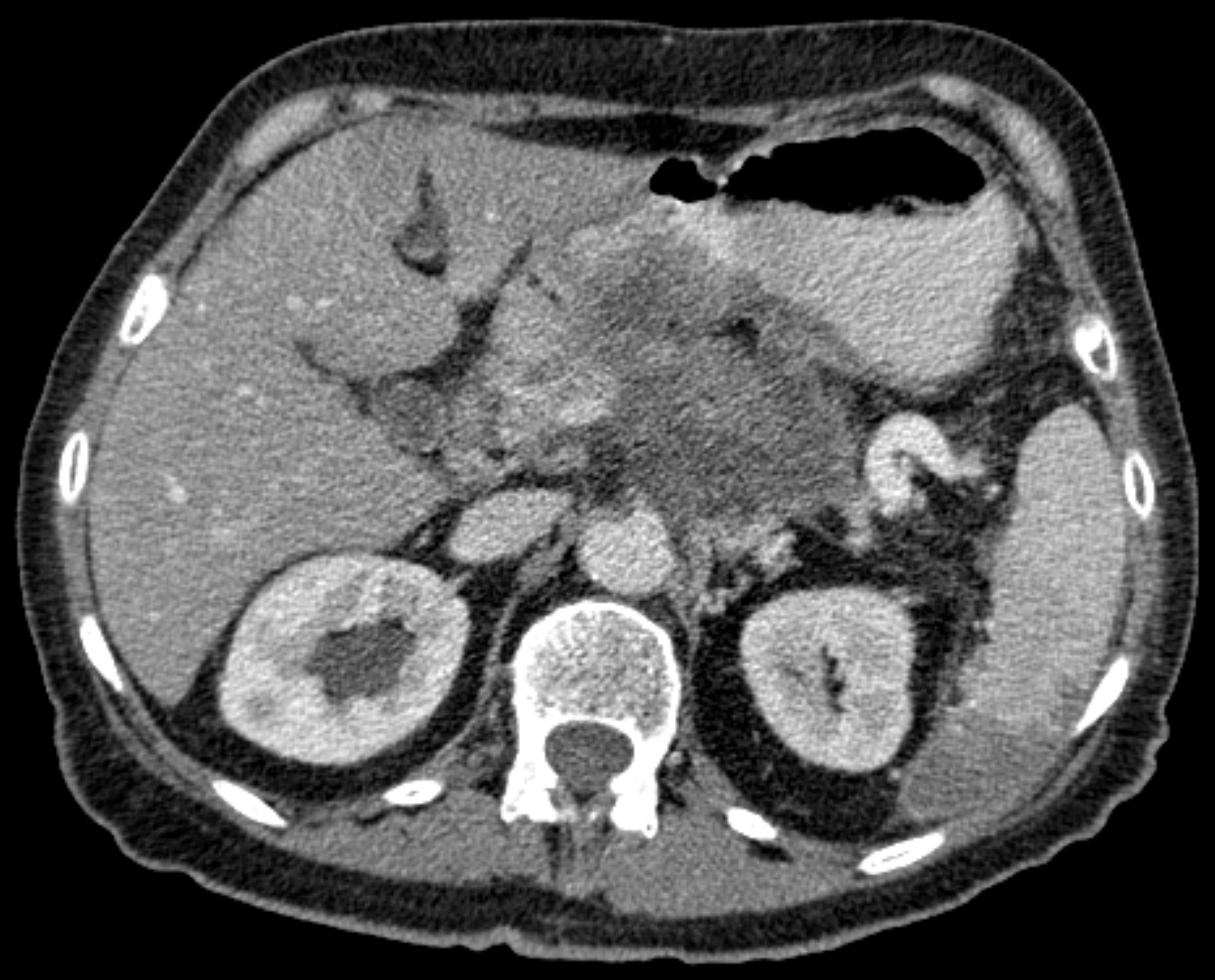With Pancreatic Cancer set to be the third leading diagnosed Cancer in Canada over the coming years, any studies that advance our ability to reduce pain, especially the severe abdominal pain associated with late-stage pancreatic cancer is an achievement in itself.
We’ve stressed the importance time and time again of early interventions in your journey with Pancreatic Cancer. That applies to so many potential treatment options- nerve block or palliative care—have those conversations early so you know what’s in your toolbox.
I remember the disappointment when my mother returned from her failed nerve block procedure after the tumour had blocked a clear path to the nerves.
Seeing how quickly the landscape of Pancreatic Cancer treatment changes in noting the amendment of US guidelines for pancreatic cancer treatment after this studies findings is reassuring knowing that we are making real progress towards better outcomes. We’ll be updating our database of treatment options to include this change here at Team Heather as well.
Understanding Pancreatic Cancer Pain
Although the direct cause is not fully understood, Pancreatic cancer frequently causes intense abdominal pain in its later stages when the tumor makes it‘s way closer to the bundle of nerves called the Celiac Plexus.

This pain often radiates to the back. According to Pancreatic Cancer Canada, this pain can be debilitating and significantly reduce a patient's quality of life. Existing pain management methods, like oral opioids or the Plexus Nerve Block, while effective, may have their own limitations or complications but generally both have a low side effect profile.
What exactly is this new alternative to the plexus nerve block?
This new radio-surgery treatment targets the celiac plexus nerve to alleviate pain presumably aggravated by the growth of the tumor. It’s a quick, outpatient procedure which means it can be done and you can go home the same day.
Key Findings from the Study
The study findings Celiac Plexus Radio-Surgery for Pain Management was conducted in Israel, Portugal, the United States, and, interestingly, right here in Canada at Princess Margaret Cancer Center and finished on November of 2022.
Durable Pain Reduction: The study found that over half (53%) of participants noticed a significant reduction in pain. However, as with any study that studies pain, we have to accept the limitations of how we quantify pain in that pain is very much a personal experience. What some may describe as uncomfortable pain, others may feel it’s unbearable.
Minimal Side Effects Profile: Quite similar to the traditional plexus nerve block, assuming there are no complications with the procedure, it maintains a minimal side effect profile. The most common complaints on the day of treatment are fatigue and nausea. Bear in mind that the side effects of any existing treatment will be more comprehensive and have been studied longer than any new treatment that is introduced.

Critical Eye 👁️
Introduces critical considerations for readers to maintain a balanced perspective on study findings. News outlets may prioritize marketing goals and cherry pick findings to attract audiences, rather then providing the full picture.
Quantifying Pain is difficult: Quantifying pain in any setting, let alone clinically, can be challenging as pain is a deeply personal experience, and different people may scale pain differently. Pain is quantified in clinical trials via the BPI Pain scale.
Patients still take existing opioid medications post-procedure: Participants in this trial were not required to halt the use of their existing opioid medications after the procedure. Although they were required to report the use of opioid medications post-procedure, this can create difficulty in quantifying the response to the procedure.
Minimal Side Effects Still Suck: While side effects can be reported as minimal, we have to bear in mind that even side effects like nausea or diarrhea, which some of us only experience once or twice, can minimize the reality of experiencing these side effects repetitively due to a medication (opioids) which provide needed pain relief.
The Role of Celiac Plexus Block in Pain Management
Celiac plexus block is a well-established technique for managing abdominal pain, particularly in pancreatic cancer patients. The celiac plexus is a network of nerves near the stomach, pancreas, and other abdominal organs. Traditional nerve block procedures involve injecting pain-relieving medication directly into this nerve cluster to interrupt the transmission of pain signals to the brain.
Footage of a Celiac Plexus Nerve Block on a monitoring screen: (Video Credit: IRFacilities)
The effectiveness of celiac plexus block in reducing pain varies among individuals. The 30-60 minute procedure has a high success rate. According to PanCAN, the celiac plexus block can “relieve significant pain for up to 70% to 90% of patients.” The pain relief from this procedure typically lasts for several months and can be repeated if necessary.
However, not all patients are candidates for this procedure, mainly if the cancer has obstructed access to the nerve cluster, as was the case with my mother.
Comparing the Plexus Nerve Block to this New Treatment
Less Invasive: Both the existing nerve block and this new approach to treating pancreatic cancer pain can be performed as outpatient procedures. This means patients can have the procedure completed and go home the same day. This is a significant advantage as it reduces hospital stays and associated costs and allows patients to recover in the comfort of their own homes.
Fewer Side-Effects: The plexus nerve block side effect profile and that of this new method for managing the pain associated with Pancreatic Cancer are both on the smaller side without complications. This new approach does not introduce problems with low blood pressure as seen in nerve blocks, a common side effect due to the proximity of the celiac plexus to major blood vessels.
Longer Lasting Relief: According to PanCAN which states traditional plexus nerve blocks offer anywhere between three and six months of pain reduction—the new treatment has shown promise in providing longer-lasting relief. Participants in the trial reported significant pain reduction that extended beyond the typical duration seen with nerve blocks, highlighting the potential for this new method to offer more sustained pain management.
Reduced Opioid Dependence: Effective pain management through this radiosurgery approach can decrease the reliance on high doses of opioid medications that, while providing pain relief, come with a much more severe side effect profile that, while addressing one need by reducing pain, creates more problems. Reduced dependence on opioids means fewer side effects like constipation, nausea, and the risk of addiction, which can significantly improve patients’ quality of life.
Exploring other methods
According to John Hopkins, these methods made be used in addition to, or on their own.
Nerve Cutting Surgery: Thoracoscopic splanchnicectomy, surgeons cut out specific branches of the nerve bundle.
Guided Nerve Block: Radiologists are guided by a small camera as they enter through the stomach and inject pain medication into the nerves near the pancreas.
Benefits Beyond Pain Management
This new radiation therapy offers other significant benefits in addition to alleviating pain. It targets and attacks pancreatic cancer cells, making them vulnerable to the immune system. This dual approach not only provides pain relief but also contributes to the overall treatment of the cancer, potentially slowing disease progression and improving survival rates.
Who Benefits from Clinical Trials?
For patients with metastatic pancreatic cancer who can undergo traditional plexus nerve block, the procedure already has benefits, many of which improve quality of life, including an overall reduction in opioid use (pretty simple logic here, if we can reduce the pain using other methods, it reduces the need for opioids). Opioids are not a solution either; they often come with their side effect profile, which makes the side effects of these procedures seem like a walk in the park.

Clinical trials play a crucial role in advancing cancer treatment and pain management. They provide patients access to cutting-edge therapies that are not yet widely available and contribute to the scientific understanding of how these treatments work. Participants in clinical trials also receive close monitoring and comprehensive care from a team of specialists, which can lead to better overall health outcomes.
Conclusion
The new treatment targets tumour cells to alleviate pain. It also aims to target and attack pancreatic cancer cells, making them vulnerable to the immune system. With the promising results from the study, including durable pain reduction and minimal side effects, this new form of radiation therapy represents a significant advancement in the management of pancreatic cancer pain.
By integrating these new insights and technological advancements into treatment plans, we move closer to offering pancreatic cancer patients relief from their pain and a tangible improvement in their overall prognosis and quality of life. The future of pancreatic cancer treatment looks brighter with each discovery.
What is this new treatment for people living with pancreatic cancer?
Researchers have developed a new kind of radiosurgery to help manage pain in pancreatic cancer patients. This treatment focuses on the celiac plexus nerve, which is responsible for transmitting pain signals from the abdomen, where the pancreas is located.
By using high doses of targeted radiation, this treatment can interrupt pain signals, offering relief that may last longer than other methods. Because it’s non-invasive (meaning no surgery or incisions), patients can often go home the same day, and it is performed on an outpatient basis. This approach provides an alternative for patients who might otherwise rely on regular procedures or high doses of medication to manage their pain.
How does the new treatment compare to the existing Celiac Plexus Nerve Block?
Existing celiac plexus nerve blocks typically involve injecting anesthetic or steroid medication directly into the celiac plexus nerve to block pain. While effective, these blocks tend to provide relief that lasts only a few months, meaning patients need to repeat the procedure frequently.
In contrast, this new radiosurgery treatment uses highly focused radiation to target the nerve, potentially offering pain relief that lasts longer than traditional injections.
This radiosurgery approach also comes with fewer risks of complications and may reduce the patient’s need for opioid painkillers, which can lead to dependency issues. This lasting effect and lower need for follow-up make it a promising option for long-term pain management.
What are the most common complications of celiac plexus block?
The most common complications are hypotension (low blood pressure), diarrhea, transient back pain. The pain may also temporarily worsen before it gets better. These symptoms usually go away on their own within a day or two.
Unlike opioid medications, which can cause long-term side effects such as drowsiness, constipation, and risk of addiction, this procedure’s side effects are short-lived and manageable. Because it is non-invasive, it avoids the risks associated with surgery, such as infection or prolonged recovery, making it a safer option for many patients.
Is this treatment available now for all pancreatic cancer patients?
At this time, the new radiosurgery treatment is still being tested in clinical trials and is available only at certain research hospitals or medical centers participating in these studies. These trials are ongoing in several countries, including Canada, so the treatment is not yet widely accessible. Not all patients may qualify for these trials, as each study has specific eligibility criteria, such as cancer stage and overall health.
Patients interested in this treatment are encouraged to talk to their healthcare providers about clinical trial options and whether this treatment could be right for them. If trials show positive results, this treatment could eventually become more widely available.
Does this new treatment affect cancer itself, or only the pain?
The main purpose of this new radiosurgery is to manage pain by targeting the nerves that transmit pain signals, not to treat the cancer itself.
However, there is some evidence to suggest that by helping patients feel better and experience less pain, this treatment can improve their overall quality of life and help them respond better to other cancer treatments. Some studies also suggest that pain management can support immune function by reducing stress on the body, which may be beneficial, although it does not replace traditional cancer therapies like chemotherapy.
The main focus, however, remains on making patients more comfortable and reducing their pain levels so they can better handle other aspects of their treatment and daily life







